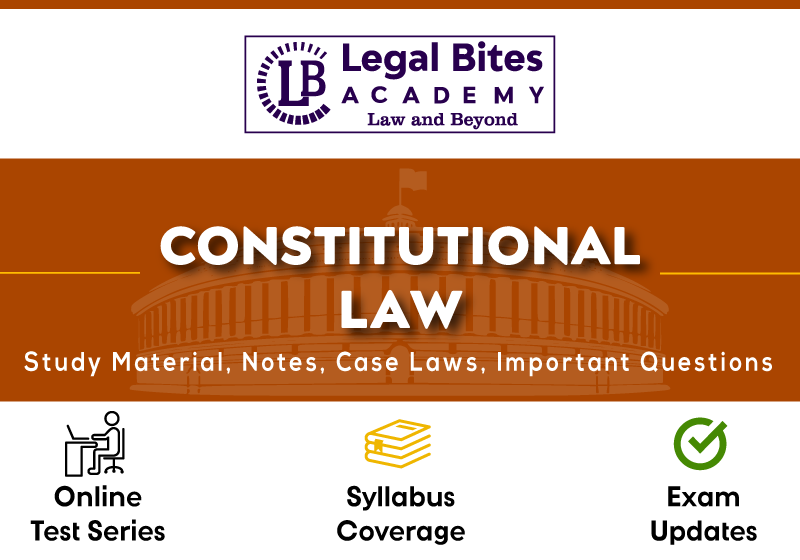A law fixes the ratio of advertisement space of newspapers at ten percent of the total space available. Examine the Constitutional validity of the law.
Question: A law fixes the ratio of advertisement space of newspapers at ten per cent of the total space available. Examine the Constitutional validity of the law.[BJS1975] Find the answer to the mains question only on Legal Bites. [A law fixes the ratio of advertisement space of newspapers at ten per cent of the total space available. Examine… Read More »

Question: A law fixes the ratio of advertisement space of newspapers at ten per cent of the total space available. Examine the Constitutional validity of the law.[BJS1975] Find the answer to the mains question only on Legal Bites. [A law fixes the ratio of advertisement space of newspapers at ten per cent of the total space available. Examine the Constitutional validity of the law. Answer Article 19(1) (a) of the Indian Constitution secures to every citizen the freedom of speech and...
Question: A law fixes the ratio of advertisement space of newspapers at ten per cent of the total space available. Examine the Constitutional validity of the law.[BJS1975]
Find the answer to the mains question only on Legal Bites. [A law fixes the ratio of advertisement space of newspapers at ten per cent of the total space available. Examine the Constitutional validity of the law.
Answer
Article 19(1) (a) of the Indian Constitution secures to every citizen the freedom of speech and expression and should be read with clause(2) which empowers the state to put reasonable restrictions. Freedom of speech and expression means the right to express one’s convictions and opinions freely by the word of mouth, writing, printing, pictures, electronic media or any other mode addressed to the eye or the ear. It also includes the right to publish views of other people i.e. freedom of the press.
The liberty of the press consists in printing without any license subject to the consequences of the law. Thus the liberty of press means liberty to print and publish what one pleases, without previous permission. This freedom is not only confined to newspapers and periodicals, it also includes pamphlets, circulars, and every sort of publication giving information and opinion.
Freedom to circulate extends not merely to the matter which the press is entitled to circulate but also the volume of circulation. This freedom would be undermined by an excessive burden imposed on the press which narrows its scope of dissemination of information / renders it so uneconomical as to ultimately compel it to seek Government aid, which would obviously destroy its freedom.
In Sakal Paper v. Union of India (AIR 1962 SC 305), the court held that it would be an unreasonable restriction on the Freedom of the press, under Article 19(2), if price fixation is calculated to curtail the circulation of particular newspapers.
In Bennett Coleman & Co. v. Union of India (AIR 1973 SC 106) the newsprint control order was challenged as violative of fundamental rights guaranteed under Article 19(1)(a) and 14 of the constitution as it fixed the maximum number of pages i.e., 10 pages which a newspaper could publish with an allowance of 20% increase only to newspaper below 10 pages. The court further held that the ceiling of pages affects the economic viability of the newspaper and also restricts the freedom of expression.
The ceiling of pages not only entails the reduction of circulation and denudes the area of coverage of news and views but also results in ‘reduction of space allotted for advertisement. Fall in advertisements makes the paper economically unviable.
Therefore, the law in the present case at hand which fixes the ratio of advertisement space of newspapers at ten percent of the total space available is to be held arbitrary, unreasonable, and hence in violation of the freedom of speech and expression of the press under Article 19(1)(a).
The foregoing freedom would thus be affected by any law/ State action:
- Which fixes a max no of pages which a newspaper would be entitled to print
- Which prohibits a newspaper to publish a supplement or a new edition without permission of the government – to be granted/refused to be granted, as its unfettered discretion.
- Which fixes a minimum price which a newspaper must charge, according to the no of pages which it is entitled to publish under that law, i.e., by laying down a price – scale varying with the no of pages printed.
- This reduces the space for advertisement; because if the space for advertisement is reduced, earnings will decline, and if the price has to be raised, that would affect circulation
- Government making a discriminatory distribution of its own advertisements
Important Mains Questions Series for Judiciary, APO & University Exams
- Constitutional Law Mains Questions Series Part-I
- Constitutional Law Mains Questions Series Part-I
- Constitutional Law Mains Questions Series Part-II
- Constitutional Law Mains Questions Series Part-IV
- Constitutional Law Mains Questions Series Part-V
- Constitutional Law Mains Questions Series Part-VI
- Constitutional Law Mains Questions Series Part-VII
- Constitutional Law Mains Questions Series Part-VIII
- Constitutional Law Mains Questions Series Part-IX
- Constitutional Law Mains Questions Series Part-X
Admin Legal Bites
Legal Bites Study Materials correspond to what is taught in law schools and what is tested in competitive exams. It pledges to offer a competitive advantage, prepare for tests, and save a lot of money.

